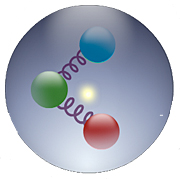Home > Press > New measurement explores fine details of proton structure
 |
| During the experiment, the probing electron seems to give all of its momentum to one quark, which then passes part of it on to the proton's other quarks. |
Abstract:
A new, high-precision measurement of the proton's hidden inner structure carried out at DOE's Jefferson Lab has yielded a surprising result.
New measurement explores fine details of proton structure
Newport News, VA | Posted on August 30th, 2010A collaboration of scientists measured the proton's form factors, quantities that describe the shape and size of the space over which the electric charge and electric current is spread.
The proton gets its charge from its building blocks: three quarks. The electric charge form factor, GEp, is connected to the electric field generated by the quarks' electric charges. As the charged quarks move around, they generate an electric current, which creates a magnetic field. The magnetic form factor, GMp, is therefore related to the quarks' movement.
The experiment set out to measure the ratio of the two form factors:
GEp/GMp. Previous measurements by the collaboration found that the electric charge form factor decreases significantly faster than the magnetic form factor. The new experiment measured the smallest value of the ratio by 50 percent.
In the experiment, the proton was probed with high-energy electrons from Jefferson Lab's CEBAF accelerator. The angle at which the electrons leave the proton was then measured, determining the so- called momentum transfer.
The experimenters found that the decrease revealed in previous measurements shows indications of slowing down. This slowing could indicate that the momentum transfer is approaching the region in which the electron probe is no longer probing the proton as a whole, but is beginning to study the individual quarks.
In addition, the researchers suspect they are also seeing a special circumstance of how the electron probe is interacting with the proton and its quarks. The electron carries enough energy to shatter the proton, but intact protons are detected. The electron seems to give its momentum to one quark, which then passes part of it on to the proton's other quarks.
The result was recently published in the journal Physical Review Letters.
####
For more information, please click here
Contacts:
Kandice Carter
757.269.7263
Copyright © Jefferson Lab
If you have a comment, please Contact us.Issuers of news releases, not 7th Wave, Inc. or Nanotechnology Now, are solely responsible for the accuracy of the content.
| Related News Press |
News and information
![]() Researchers develop molecular qubits that communicate at telecom frequencies October 3rd, 2025
Researchers develop molecular qubits that communicate at telecom frequencies October 3rd, 2025
![]() Next-generation quantum communication October 3rd, 2025
Next-generation quantum communication October 3rd, 2025
![]() "Nanoreactor" cage uses visible light for catalytic and ultra-selective cross-cycloadditions October 3rd, 2025
"Nanoreactor" cage uses visible light for catalytic and ultra-selective cross-cycloadditions October 3rd, 2025
Physics
![]() Quantum computers simulate fundamental physics: shedding light on the building blocks of nature June 6th, 2025
Quantum computers simulate fundamental physics: shedding light on the building blocks of nature June 6th, 2025
![]() A 1960s idea inspires NBI researchers to study hitherto inaccessible quantum states June 6th, 2025
A 1960s idea inspires NBI researchers to study hitherto inaccessible quantum states June 6th, 2025
![]() Magnetism in new exotic material opens the way for robust quantum computers June 4th, 2025
Magnetism in new exotic material opens the way for robust quantum computers June 4th, 2025
Academic/Education
![]() Rice University launches Rice Synthetic Biology Institute to improve lives January 12th, 2024
Rice University launches Rice Synthetic Biology Institute to improve lives January 12th, 2024
![]() Multi-institution, $4.6 million NSF grant to fund nanotechnology training September 9th, 2022
Multi-institution, $4.6 million NSF grant to fund nanotechnology training September 9th, 2022
Announcements
![]() Rice membrane extracts lithium from brines with greater speed, less waste October 3rd, 2025
Rice membrane extracts lithium from brines with greater speed, less waste October 3rd, 2025
![]() Researchers develop molecular qubits that communicate at telecom frequencies October 3rd, 2025
Researchers develop molecular qubits that communicate at telecom frequencies October 3rd, 2025
![]() Next-generation quantum communication October 3rd, 2025
Next-generation quantum communication October 3rd, 2025
![]() "Nanoreactor" cage uses visible light for catalytic and ultra-selective cross-cycloadditions October 3rd, 2025
"Nanoreactor" cage uses visible light for catalytic and ultra-selective cross-cycloadditions October 3rd, 2025
Research partnerships
![]() Lab to industry: InSe wafer-scale breakthrough for future electronics August 8th, 2025
Lab to industry: InSe wafer-scale breakthrough for future electronics August 8th, 2025
![]() HKU physicists uncover hidden order in the quantum world through deconfined quantum critical points April 25th, 2025
HKU physicists uncover hidden order in the quantum world through deconfined quantum critical points April 25th, 2025
|
|
||
|
|
||
| The latest news from around the world, FREE | ||
|
|
||
|
|
||
| Premium Products | ||
|
|
||
|
Only the news you want to read!
Learn More |
||
|
|
||
|
Full-service, expert consulting
Learn More |
||
|
|
||








